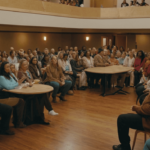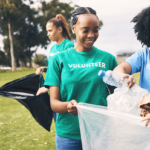Giving back to your local community is a fulfilling way to make a positive difference, foster relationships, and strengthen the bonds that make neighborhoods thrive. Although the prospect of getting started might seem overwhelming, there are many approachable ways to begin contributing, regardless of time, resources, or skills. Whether through volunteering, supporting local businesses, or engaging in environmental efforts, every small act counts. In this article, we’ll explore simple yet impactful ways to give back, explain why each approach matters, and show how you can start right now.
Volunteering Your Time
One of the most direct ways to give back to your community is by volunteering. This doesn’t require any particular skill set or a large time commitment—just a willingness to contribute. Many communities have a range of volunteer opportunities available that cater to various interests and abilities.
Why Volunteering Matters
Volunteering has immediate benefits for both the community and the individual. Community organizations such as food banks, schools, shelters, and non-profits rely on volunteers to function. Volunteers help deliver services that might not be possible otherwise due to limited budgets or staffing constraints. Moreover, volunteering fosters a sense of community ownership and engagement; people feel more invested in their neighborhoods and develop a sense of pride.
Volunteering also offers personal benefits, including increased well-being, new skills, and valuable connections with others. Research indicates that people who volunteer experience a greater sense of purpose and reduced stress levels, making it beneficial to both mental and physical health.
How to Get Started with Volunteering
Begin by identifying local organizations that align with your interests. For example, if you enjoy working with children, look for mentorship programs or after-school tutoring opportunities. If you’re passionate about the environment, join a local conservation group or organize a community cleanup.
Online resources like VolunteerMatch, community boards, or local government websites often list volunteer opportunities. Many organizations allow for flexible scheduling, making it easy to start small, even if you only have a few hours per month.
Supporting Local Businesses
Choosing to shop locally is another powerful way to give back to your community. By supporting local businesses, you’re helping to stimulate the local economy, create jobs, and preserve the unique character of your community.
Why Supporting Local Businesses Makes a Difference
Local businesses contribute significantly to the community’s economy. Studies have shown that when you shop at a local business, a much larger portion of that money stays within the community compared to when you shop at a chain store. Local businesses also create job opportunities for residents, provide services and goods with a personal touch, and often sponsor community events or charitable causes.
Shopping locally also reduces the environmental impact associated with long-distance shipping. Local businesses often source goods and services from nearby, which cuts down on transportation emissions, creating a positive environmental impact.
How to Start Supporting Local Businesses
Consider shifting a portion of your regular shopping to local stores. For instance, buy your groceries from a local market, dine at neighborhood restaurants, or purchase gifts from small shops. Start by exploring small businesses in your area and commit to supporting them regularly.
Additionally, you can support local businesses by spreading the word. Share your positive experiences on social media, recommend businesses to friends and family, and leave good reviews online. These actions can go a long way in helping these businesses thrive.
Engaging in Community Clean-Ups and Environmental Efforts
Keeping your community clean and green is a meaningful way to give back and make a visible impact. Clean neighborhoods are safer, more enjoyable, and attract new residents and businesses, enhancing the overall quality of life for everyone.
The Importance of Environmental Stewardship in Communities
Environmental stewardship helps communities reduce pollution, preserve green spaces, and combat climate change. When community members come together for clean-up events, tree planting, or recycling programs, it fosters a culture of respect for the environment. Additionally, clean and well-maintained public spaces contribute to better mental and physical health for residents, as they’re more likely to spend time outdoors and engage in physical activities.
How to Get Involved in Environmental Activities
Joining or organizing a community clean-up event is a straightforward way to begin. You can participate in a scheduled event or simply gather friends and neighbors to clean a park, beach, or street. Many organizations provide supplies like gloves, bags, and tools, making it easy to get started.
Recycling and composting initiatives are also effective ways to reduce waste in your community. Learn about recycling rules in your area and advocate for better recycling infrastructure if needed. Composting, whether done individually or through a community program, reduces landfill waste and creates nutrient-rich soil that can be used in local gardens.
Mentoring and Supporting Youth Programs
Youth programs play a vital role in building a strong community by providing children and teens with the resources, support, and guidance they need to succeed. By getting involved in youth-focused initiatives, you’re investing in the future of your community.
Why Mentorship is Beneficial for Communities
When young people have positive role models and mentors, they’re more likely to thrive academically, socially, and emotionally. Mentorship programs create safe spaces for youth to develop their interests, build confidence, and learn essential life skills. As a result, mentored youth are more likely to pursue education, avoid risky behaviors, and contribute positively to the community as they grow.
Youth programs can also bridge generational gaps, encouraging understanding and respect between different age groups. When adults engage with young people, they share valuable experiences and insights, creating stronger community bonds.
How to Begin Mentoring or Supporting Youth Programs
There are many ways to engage with youth programs, including after-school tutoring, sports coaching, or leading workshops in areas like art, science, or technology. Local schools, community centers, and non-profits often seek mentors, so reach out to organizations in your area to learn about available opportunities.
If direct mentorship isn’t possible, consider supporting youth programs through donations or by advocating for better youth resources in your community. Every effort contributes to empowering the next generation.
Participating in Local Events and Fundraisers
Attending local events and fundraisers is an enjoyable way to support your community. These events bring residents together, celebrate local culture, and often raise funds for important causes or community projects. From festivals and charity runs to school fairs and neighborhood block parties, local events strengthen community spirit and provide opportunities for giving back.
The Power of Community Events
Local events foster a sense of unity and pride among residents. They provide a platform for people to connect, share ideas, and collaborate on community goals. Fundraisers, in particular, raise money for critical needs, such as healthcare, education, and public safety, often addressing issues that directly impact the quality of life for community members.
Additionally, events give small businesses and artisans a platform to showcase their products, which helps to stimulate the local economy.
How to Get Involved in Local Events
Start by attending events in your area and encouraging others to join. Support local fundraisers by making donations, participating in events, or volunteering to help organize. Many communities have annual traditions that residents can participate in, such as holiday parades, sports tournaments, or art fairs.
If you have the resources, consider hosting your own event or fundraiser for a cause that’s important to you. Organizing even a small gathering, like a neighborhood potluck, can help bring people together and inspire a stronger community connection.
Conclusion
Giving back to your local community is a journey that starts with small steps but leads to powerful changes. By volunteering your time, supporting local businesses, participating in environmental efforts, mentoring youth, and engaging in community events, you’re investing in a brighter, more connected future for everyone.
Whether it’s spending an hour volunteering, choosing to shop locally, or joining a community clean-up, every action counts. When individuals take small steps toward positive change, it creates a ripple effect that can transform communities into thriving, supportive places where everyone can feel proud to belong. As more people become inspired to give back, these efforts build momentum, creating lasting benefits that strengthen communities for generations to come.










